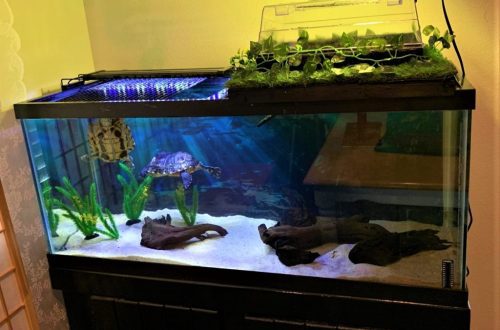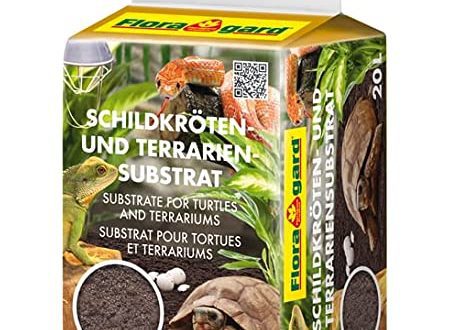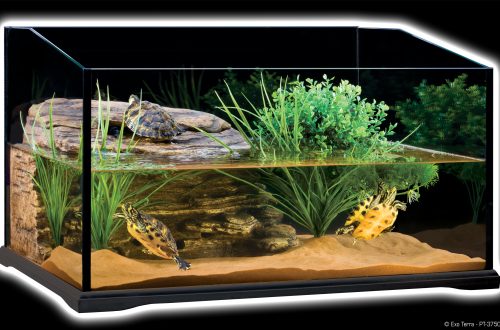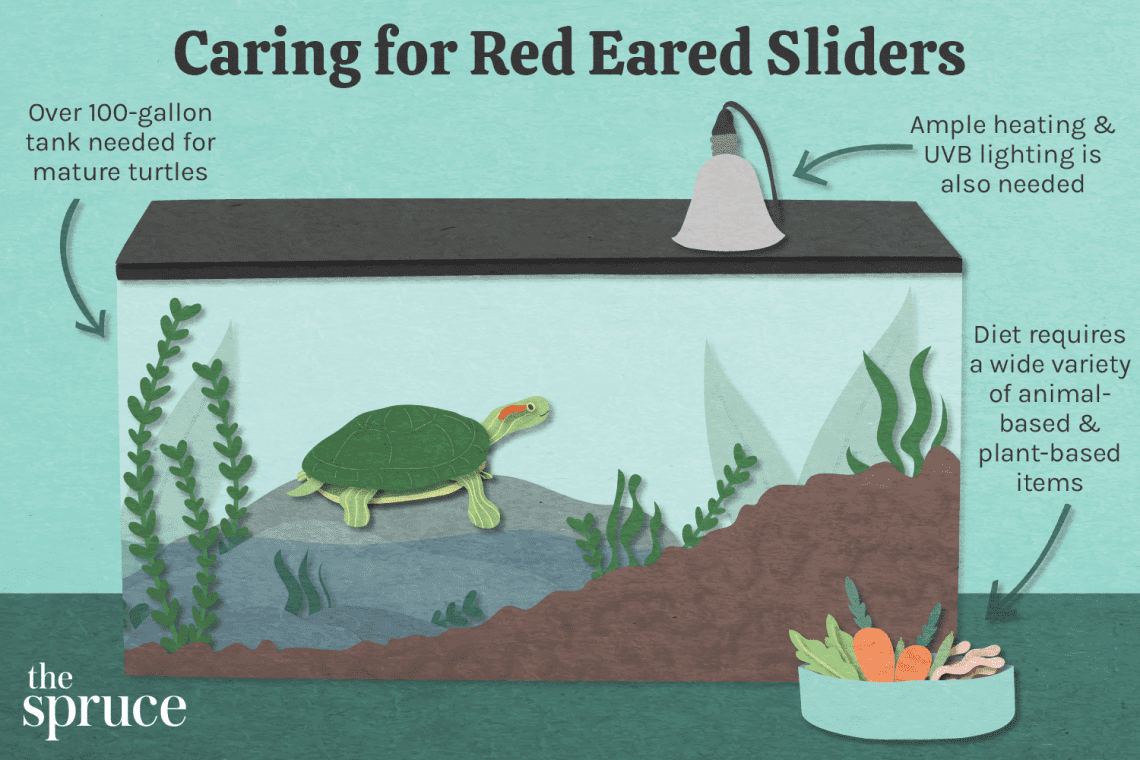
Care and maintenance of the red-eared turtle at home, how to properly care for and feed a pet
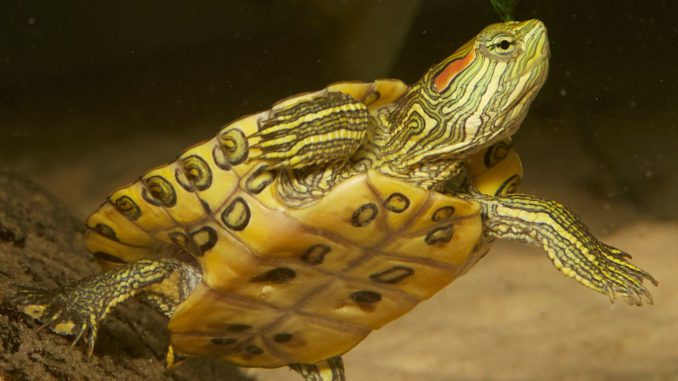
Red-eared turtles are a popular reptile species purchased as pets. For a long life of an unusual family member, it is important to prepare in advance for possible difficulties and future responsibilities.
Consider the basic rules for keeping, caring for and feeding redworts living in captivity.
Contents
Required accessories
The care and maintenance of a red-eared turtle at home implies the presence of mandatory accessories that are responsible for the formation of an artificial habitat necessary for the life of a reptile:
- aquaterrarium;
- lamps;
- filters;
- 100 W water heater;
- thermometer.
The list of additional accessories includes decorative elements that allow you to decorate the space inside the aquarium (plants, stones). They do not carry practical value, but require competent selection in order to avoid possible danger to the pet.
IMPORTANT! The conditions of detention exclude the presence of poisonous plants and fine soil that can get stuck in the throat or injure the turtle’s esophagus when swallowed.
Features of choosing an aquarium and its arrangement
Krasnoushka will need a spacious rectangular aquarium with a volume of at least 100 liters. When pouring water, start from the size of the shell. The turtle must flip freely during the swims. With the growth of the body or the increase in the number of reptiles living together, it is necessary to choose a larger aquaterrarium.
IMPORTANT! If you care for a small red-eared turtle in cramped conditions, then you will not be able to maintain its original size. A disturbed growth process will lead to a curvature of the body and the development of pathologies.
Aquatic turtles spend most of their time in the water, so you need to take care of the following indicators:
- Water level. The purity of water is directly related to its quantity. Small aquariums will need to be cleaned more frequently.
- Temperature. Heat-loving reptiles need water with a temperature of 22° to 28°. At lower values, activity is lost, and at higher values, the turtle may die from overheating.
IMPORTANT! If the room temperature is far from ideal, use a water heater.
- Cleanliness. If you keep the red-eared turtle in a large aquarium (more than 150 liters) with a powerful filtration system, then it is enough to completely change the water once a month. With more modest dwelling parameters, a weak filter or its absence, the frequency of cleaning increases to several times a week.
IMPORTANT! To place an aquaterrarium, the quietest and most remote place in the house, excluding drafts, is suitable.
At home for turtles, you can use ordinary tap water, settled for a day. This will help weather the bleach and bring it to room temperature.
Keeping red-eared turtles at home is not complete without an artificial shore – a small piece of land that occupies 25% of the aquaterrarium. Ready-made islets are sold in pet stores and are equipped with:
- sloping rise, allowing you to easily get out of the water;
- stable and textured surface, excluding the presence of sharp corners and possible upheavals;
- mounts that allow you to hang the land on hooks or attach it to suction cups;
- anti-toxic coating, which excludes the formation of harmful substances in contact with water and heating lamps.
IMPORTANT! For adult red-eared turtles, it is better to choose models without fasteners with direct immersion in water. Otherwise, the island may fall with the reptile under the weight of its weight.
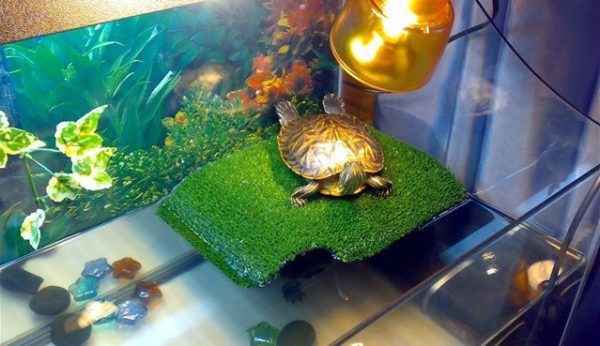
The shore is used by turtles for heating, so the temperature on land should be about 10 ° higher than the water temperature. For comfortable keeping, make sure that the temperature in the shade does not fall below 23°, and in the light – does not exceed 32°.
In addition to having sushi, you need to take care of:
- water heater. Sometimes room temperature is not enough to maintain the optimal number of degrees. Automatic temperature control is a reliable tool to avoid sudden temperature changes.
- Filters. Choose an external filtration system for more powerful cleaning and secure placement away from turtles.
- thermometer. Constant monitoring of the temperature will protect the pet from overheating and hypothermia.
- ground. Choose smooth large stones that match the size of the reptile’s head. Red-eared turtles prefer to eat aquarium plants, so choose edible or artificial options that are not dangerous for pets.
Lamps and lighting
In the wild, redworts live in the tropics, so sunbathing plays a very important role in their lives. Thanks to the sun’s rays, reptiles receive a dose of ultraviolet light, which is involved in the process of calcium absorption.
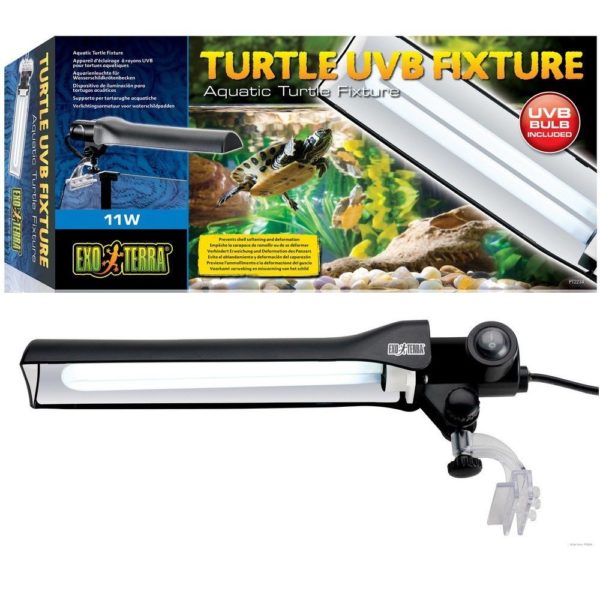
The red-eared turtle at home needs artificial sources of ultraviolet and heat. For these purposes, 3 types of lamps are used:
- Ultraviolet (UV). Turtles need a 5% UVB lamp, while larger turtles need a 10% UVB model. Such irradiation prevents the development of rickets and improves metabolism.
- heating. Used all day long for warmth while the reptile is doing its business in the water or on land.
- Infrared. Unlike an incandescent heating lamp, it does not give enough light. It is used only for the purpose of heating the aquaterrarium at night, when the temperature drops below acceptable levels.
When installing and using a heating and UV lamp, it is important:
- Place the equipment at least 30 cm from land. With a closer location, the retina of pets is at risk.
- Take care of waterproofing. Airborne splashes may damage the lamp.
- Observe the working time in the amount of 10-12 hours.
Future owners mistakenly believe that at home, the red-haired woman should live in a pack with her relatives. In the wild, reptiles live apart from each other and do not change their behavior even with the advent of offspring. The maternal instinct does not wake up in domestic turtles either, so it is recommended to remove them from the masonry.
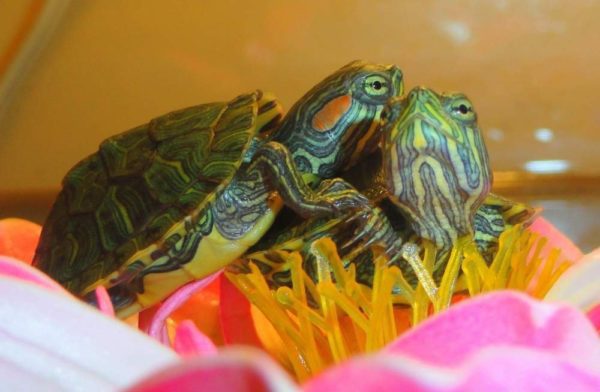
If the desire to raise several pets is too strong, then adhere to the following rules:
- Place the male in a group of females. When keeping several males, fights for a partner or territory will begin. They will have to be constantly monitored to exclude injuries during fights.
- Arrange separate feeding. In the absence of a competitor, the reptiles will show more calm behavior.
- Add space and divide it into closed zones. Sometimes increasing the volume of the aquarium is not enough, so add barriers and walls that block the view of other inhabitants.
If the joint keeping of turtles is possible under certain conditions, then the idea of uXNUMXbuXNUMXbplanting aquarium fish is immediately doomed to failure.
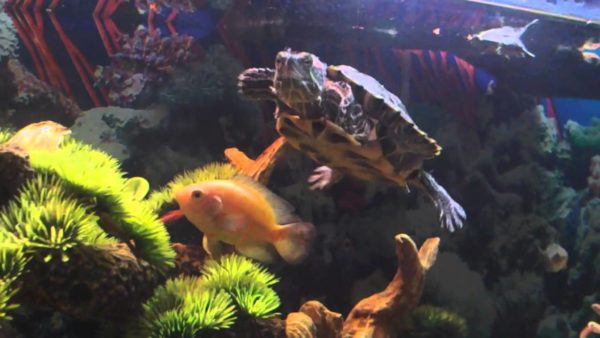
New neighbors will be perceived as live food, so waterfowl predators will deal with them in the near future. You can only take care of fish and turtles in separate aquariums, but you still have to periodically feed the reptile with guppies or crucian carp.
Feeding rules
Redworts are omnivorous reptiles, so their diet includes 2 types of food:
- Animal. Turtles are fed lean fish, seafood and insects.
- Vegetable. For feeding, ordinary grass and vegetables are suitable. Turtles are very fond of fruits, but because of the abundance of sugar, they are best given only as a treat.
IMPORTANT! Food should be close to the conditions in the wild.
When caring for a small red-eared turtle, the main emphasis is on protein foods of animal origin (90% of the total diet). When a pet grows up, it is necessary to gradually reduce the amount of animal protein (30%) in favor of vegetable (70%).
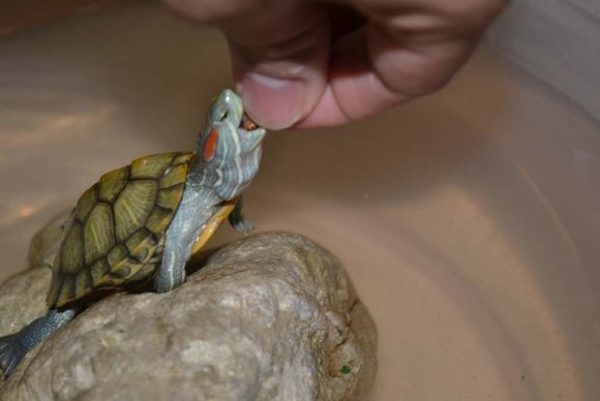
IMPORTANT! For proper growth and a strong shell, keep an eye on the amount of calcium. His turtles are obtained from fish bones and special additives.
When feeding redworts, observe:
- Frequency. Regardless of age, turtles are fed only once a day. Turtles are given food on a daily basis, and adults are given a break of 1-2 days.
- Serving Sizes. The daily portion should not exceed half of the reptile’s carapace, and 1 piece should correspond to half of its head.
- Purity. Place the turtles in a separate container. This will reduce water pollution and eliminate the need for daily cleaning of the aquarium from decaying pieces of uneaten food.
IMPORTANT! Be sure to fill the container with water used by the redworts to wet food.
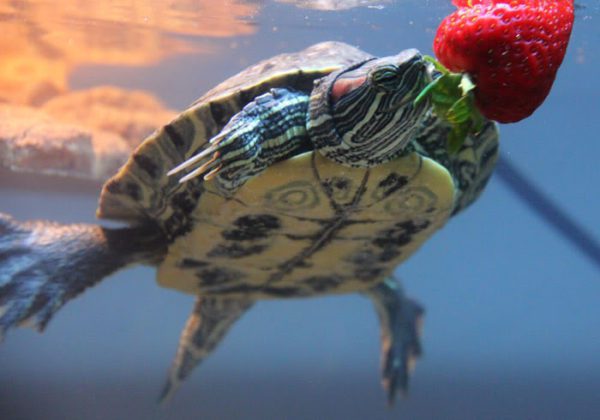
While artificial foods are recommended by veterinarians for warm-blooded animals as an alternative to natural feeding, in turtles they can only be used as a treat.
IMPORTANT! If a newborn turtle refuses to eat, and on the side of the plastron she has a small bubble, then there is no reason for concern. This is the yolk sac that supplies the babies with nutrients. The pet will show interest in the offered food after it has been resorbed.
Communication with a reptile
Caring for a red-eared turtle is fundamentally different from caring for a dog or cat. When communicating with such an unusual pet, you must adhere to the following rules:
- Always hold the turtle using 2 hands. Because of the water, the shell is too slippery, so the pet can slip out of your hands and get hurt.
- Grab the shell only from the side of the tail. This area is as far away from the head as possible, so the turtle will not be able to reach out and bite the disturber of her peace.
- Avoid close contact with the new turtle. If the pet appeared recently, then give him time to settle down and feel confident in the new territory.
- Wash your hands after every contact. You can pick up salmonellosis from your pet, so keep him away from the kitchen where food is being prepared.
IMPORTANT! Washing the aquarium in the kitchen sink is not allowed.
- Do not tap on the aquarium glass to get attention. Reptiles do not like loud noises, so this behavior can frighten them and cause psychological disturbances.
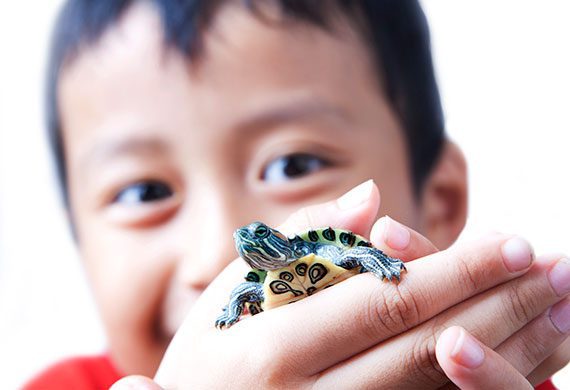
Little turtles, vulnerable physically and psychologically, deserve special attention. They need to be treated very carefully or completely excluded from communication until a certain age. Read about how to play with a turtle in the article “Games and entertainment for turtles”.
Care instructions
When caring for a red-eared cat, you will have to take care not only of the appearance of the pet, but also of the condition of the home.
Aquarium cleaning
The aquarium will have to be cleaned every week with a special antiseptic solution based on chlorhexidine. Alternatively, a mild soapy solution will do. This treatment will help get rid of bacteria and accumulated algae.
IMPORTANT! Be sure to remove the turtle while cleaning. As a temporary shelter, a container used for feeding is suitable.
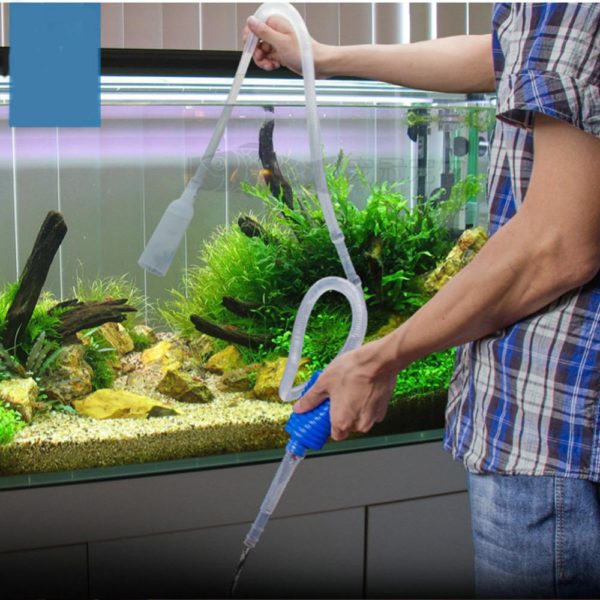
In addition to careful processing of glass with special aquarium scrapers, it is necessary to:
- Change the sponge inside the filter. Replacement is made 1 or 2 times a week. For the safety of the pet, a partial water change is done.
- Clear the soil of accumulated waste. For this purpose, a manual or electric siphon, operating on the principle of a vacuum cleaner, is suitable.
Bathing
Redheads bathe no more than 1 time per week and no more than 5 minutes in a row, using:
- a container filled with water;
- soft foam sponge;
- fragrance-free baby soap.
IMPORTANT! Don’t try to make the shell look shiny with oils or greasy lotions. They clog pores and form pathogenic microflora. Rough brushes with scrapers that can injure shell shields, and detergents with strong odors (powders, shampoos, shower gels) will not work for turtles.
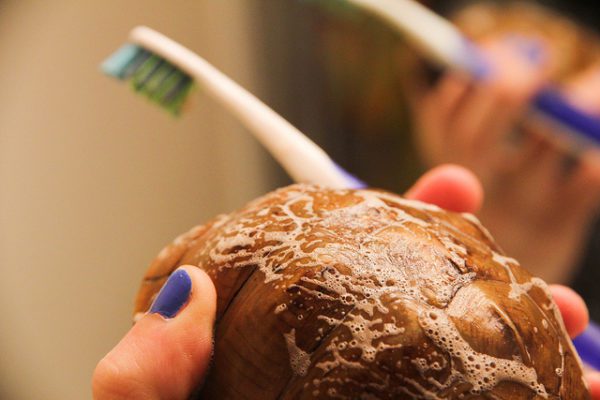
While swimming, follow these steps:
- Draw water into a container. Make sure the turtle can stand and not swallow water. Don’t let it turn upside down.
- Heat the water using a thermometer to 32°-36°. Above 36°, add cold water, and below 32° add hot water.
- Dampen the sponge and wipe the turtle from all sides. Use soap only for heavy soiling and avoid contact with eyes. IMPORTANT! Be sure to change the water if your pet has defecated while bathing.
- Dry the turtle with a soft towel or paper towels.
IMPORTANT! If a brown, indelible coating forms, buy an antifungal agent. Such a plaque is the main symptom of mycosis.
Trimming nails and beak
Long sharp claws and beak are used by redwomen to tear large pieces of food. In captivity, self-grinding is complicated in the presence of soft soil, so the owner has to cut and file the keratinized parts.
To remove the excess layer, use nail scissors or tweezers. Remember that you can cut off the light part of the claw, devoid of blood vessels.
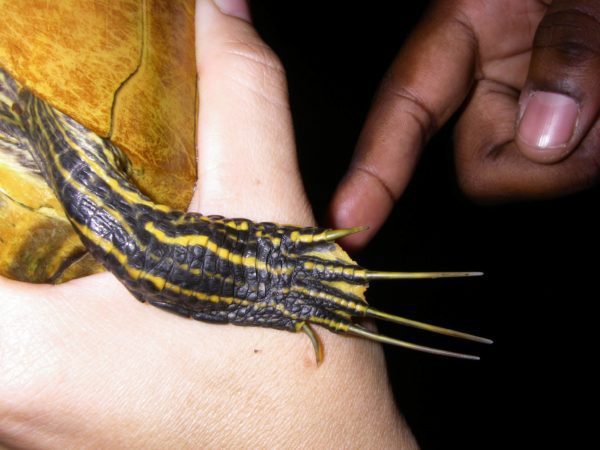
IMPORTANT! Shorten the nails only when absolutely necessary, when the reptile begins to have difficulty moving.
The hanging beak, which prevents the eating of food, is broken off with wire cutters, exposing the jagged edges. It is better to entrust such a procedure to a veterinarian in order to avoid injury to the pet.
IMPORTANT! If wounds occur, treat them with hydrogen peroxide and take the animal for examination.
Care Tips
In order to properly care for a red-eared pet, follow these tips:
- Use separate dishes for different types of food and remove the feeders half an hour after the start of feeding.
- Follow the feeding schedule. With a broken schedule, reptiles do not behave in the best way. From hunger, they begin to eat their own waste products.
- Do not add salt to the water. Redheads are freshwater reptiles, so ordinary tap water is enough for them to keep them comfortable.
- Add vitamins and minerals prescribed by a herpetologist to your food. Self-selection of the drug can lead to vitamin deficiency or hypovitaminosis.
- Thoroughly clean all corners of the aquarium. Raging algae can penetrate under the shell shields and cause mycosis.
- Control temperature conditions. Temperature is the most important indicator responsible for the health of a reptile. Do not trust your inner feelings and be sure to use measuring instruments.
- Clean the carapace with a damp cloth to avoid heavy soiling. Repeat the process several times a week.
- Do not run outside the aquarium. The turtle may be injured, eat a prohibited product, or get sick from a draft.
Features of winter care
The content of red-eared birds in winter is complicated by changing climatic conditions. Some reptiles feel the approach of cold weather even at a comfortable temperature, so they enter a state similar to hibernation.
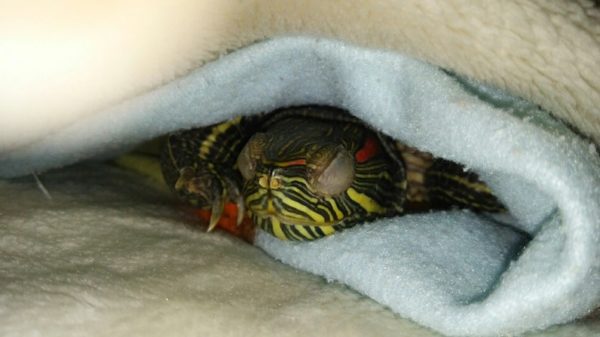
The pet becomes passive and inactive, loses interest even in their favorite foods. Do not panic and try to force feed the turtle. Cut down on portions to accommodate your new appetite and cut back on junk food.
IMPORTANT! Don’t artificially hibernate turtles. The conditions necessary for this process are difficult to reproduce at home, so a weak and sick animal may never wake up.
Actively use water heaters, avoiding temperature drop to 10°-15°. If the turtle falls asleep even in these conditions, then lower the water level and monitor the condition of the reptile daily until the end of sleep.
In addition to the winter diet and maintaining the optimum temperature, it is important to take care of the absence of drafts. During cold weather, they pose an increased danger and can reward a pet with pneumonia. Do not open the windows in the room with the aquarium, or take it to a safe place while airing.
Having decided to take care of the red-eared turtle at home, the newly minted breeder will definitely face the following difficulties:
- daily monitoring of optimal temperature conditions;
- battles for territory when keeping several pets;
- strict control of nutrition and the exclusion of life-threatening products;
- search for an experienced herpetologist who can help in case of illness.
It is also important to remember that with the right maintenance, the life of a reptile can reach 30-40 years. Long-lived turtles sometimes outlive their owners, so consider this fact when buying a new pet.
How to care for a red-eared turtle at home: rules for keeping, caring for and feeding a pet
3.1 (61.82%) 22 votes



